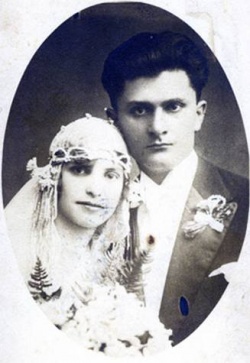Difference between revisions of "Nicolae Ionescu"
Sorindanut (talk | contribs) |
|||
| Line 5: | Line 5: | ||
|birth_date = {{birth date|1903|11|1|mf=y}} | |birth_date = {{birth date|1903|11|1|mf=y}} | ||
|birth_place = [[Bucharest]] | |birth_place = [[Bucharest]] | ||
| − | | | + | |death_place = 1974, [[Bucharest]] |
| − | |||
}} | }} | ||
== Photography == | == Photography == | ||
| − | Nicolae Ionescu ( | + | Nicolae Ionescu (1903) worked first as a typographist in [[Bucharest]]. In 1927 he got employed in the Royal Army as a photographer and began photographing the city of [[Bucharest]] but also other places in the country. In order to follow the latest developments in photography he studied German and English. In 1928 he got married and used the dowry to acquire modern equipment for the photo laboratory. |
| − | In 1930 | + | In 1930 he traveled to France and worked several months in the Lumiere factory in Lyon, and for a few months in Paris at Pathe Nathan. |
| − | |||
== Gallery == | == Gallery == | ||
| Line 18: | Line 16: | ||
== Awards == | == Awards == | ||
| − | The works of Nicolae Ionescu won second place at the Exhibition of photographs | + | The works of Nicolae Ionescu won the second place at the Exhibition of photographs in 1936, and ONT bronze plaque at the International Photography Exhibition in Bordeaux in 1957. |
== Legacy == | == Legacy == | ||
| − | + | His photographs of Bucharest from the 1920s and 1930s provide a valuable document of the city. After his death, his wife sold a large part of the negatives, and ultimately the entire collection to the municipal bookshop "Mihai Sadoveanu" and the Romanian Academy. | |
| − | |||
| − | == | + | == External links == |
* [http://blog.alexgalmeanu.com/blog/2008/01/13/nicolae-ionescu-fotograful-cronicar/ Nicolae Ionescu fotograful cronicar] | * [http://blog.alexgalmeanu.com/blog/2008/01/13/nicolae-ionescu-fotograful-cronicar/ Nicolae Ionescu fotograful cronicar] | ||
* [http://www.foto-magazin.ro/despre-fotografie_open.php?art=ftm20/archives/2008/05/nicolae_ionescu.html Nicolae Ionescu] (in Romanian) | * [http://www.foto-magazin.ro/despre-fotografie_open.php?art=ftm20/archives/2008/05/nicolae_ionescu.html Nicolae Ionescu] (in Romanian) | ||
| + | * http://www.zf.ro/ziarul-de-duminica/nicolae-ionescu-fotograful-bucurestilor-completari-la-biografie-galerie-foto-9591818/ | ||
| + | * http://www.zf.ro/ziarul-de-duminica/nicolae-ionescu-fotograful-bucurestilor-ii-galerie-foto-9638176/ | ||
| + | * [http://cs.wikipedia.org/wiki/Nicolae_Ionescu Ionescu at Czech Wikipedia] | ||
[[Category:Photography|Nicolae Ionescu]] | [[Category:Photography|Nicolae Ionescu]] | ||
Revision as of 11:19, 18 October 2013
 Photo of NicolaeIonescu and his wife. | |
| Born |
November 1, 1903 Bucharest |
|---|---|
| Died | 1974, Bucharest |
Photography
Nicolae Ionescu (1903) worked first as a typographist in Bucharest. In 1927 he got employed in the Royal Army as a photographer and began photographing the city of Bucharest but also other places in the country. In order to follow the latest developments in photography he studied German and English. In 1928 he got married and used the dowry to acquire modern equipment for the photo laboratory. In 1930 he traveled to France and worked several months in the Lumiere factory in Lyon, and for a few months in Paris at Pathe Nathan.
Gallery
....
Awards
The works of Nicolae Ionescu won the second place at the Exhibition of photographs in 1936, and ONT bronze plaque at the International Photography Exhibition in Bordeaux in 1957.
Legacy
His photographs of Bucharest from the 1920s and 1930s provide a valuable document of the city. After his death, his wife sold a large part of the negatives, and ultimately the entire collection to the municipal bookshop "Mihai Sadoveanu" and the Romanian Academy.
External links
- Nicolae Ionescu fotograful cronicar
- Nicolae Ionescu (in Romanian)
- http://www.zf.ro/ziarul-de-duminica/nicolae-ionescu-fotograful-bucurestilor-completari-la-biografie-galerie-foto-9591818/
- http://www.zf.ro/ziarul-de-duminica/nicolae-ionescu-fotograful-bucurestilor-ii-galerie-foto-9638176/
- Ionescu at Czech Wikipedia